Abstract
Rapid-flow resonance Raman vibrational spectra of bacterial photosynthetic reaction centers from the R-26 mutant of Rhodobacter sphaeroides have been obtained by using excitation wavelengths (810-910 nm) resonant with the lowest energy, photochemically active electronic absorption. The technique of shifted excitation Raman difference spectroscopy is used to identify genuine Raman scattering bands in the presence of a large fluorescence background. The comparison of spectra obtained from untreated reaction centers and from reaction centers treated with the oxidant K3Fe(CN)6 demonstrates that resonance enhancement is obtained from the special pair. Relatively strong Raman scattering is observed for special pair vibrations with frequencies of 36, 94, 127, 202, 730, and 898 cm-1; other modes are observed at 71, 337, and 685 cm-1. Qualitative Raman excitation profiles are reported for some of the strong modes, and resonance enhancement is observed to occur throughout the near-IR absorption band of the special pair. These Raman data determine which vibrations are coupled to the optical absorption in the special pair and, thus, probe the nuclear motion that occurs after electronic excitation. Implications for the interpretation of previous hole-burning experiments and for the excited-state dynamics and photochemistry of reaction centers are discussed.
Full text
PDF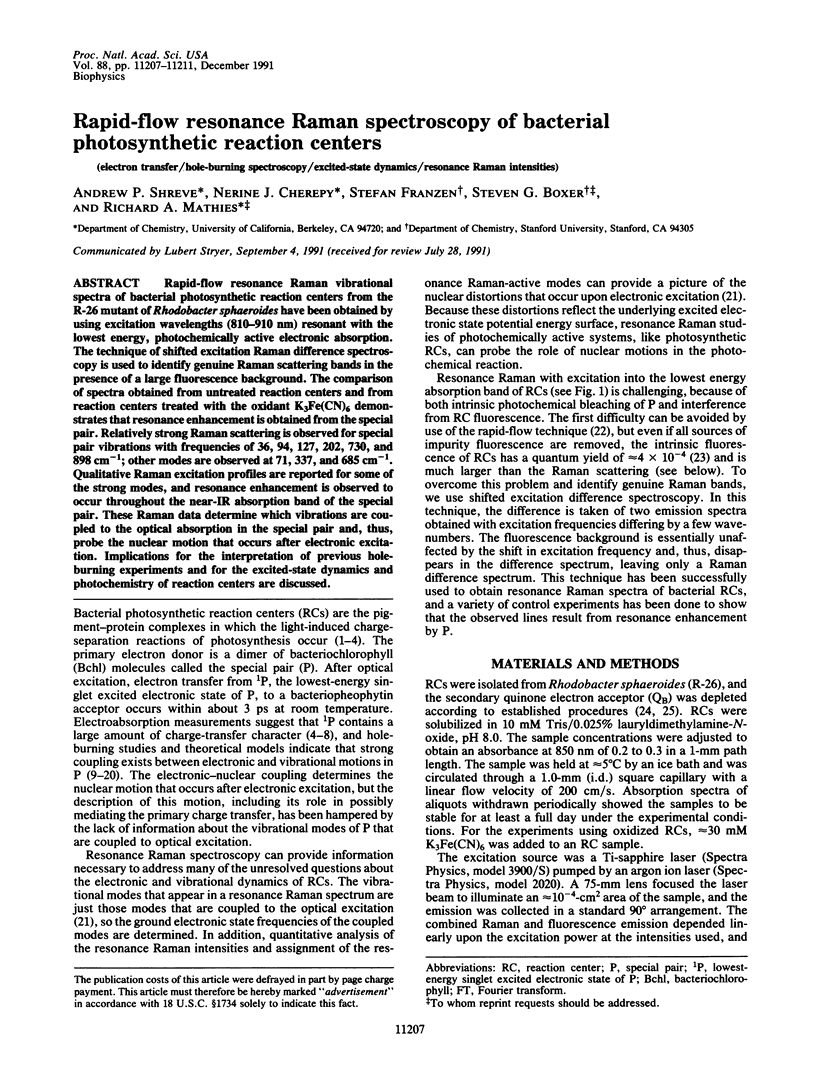
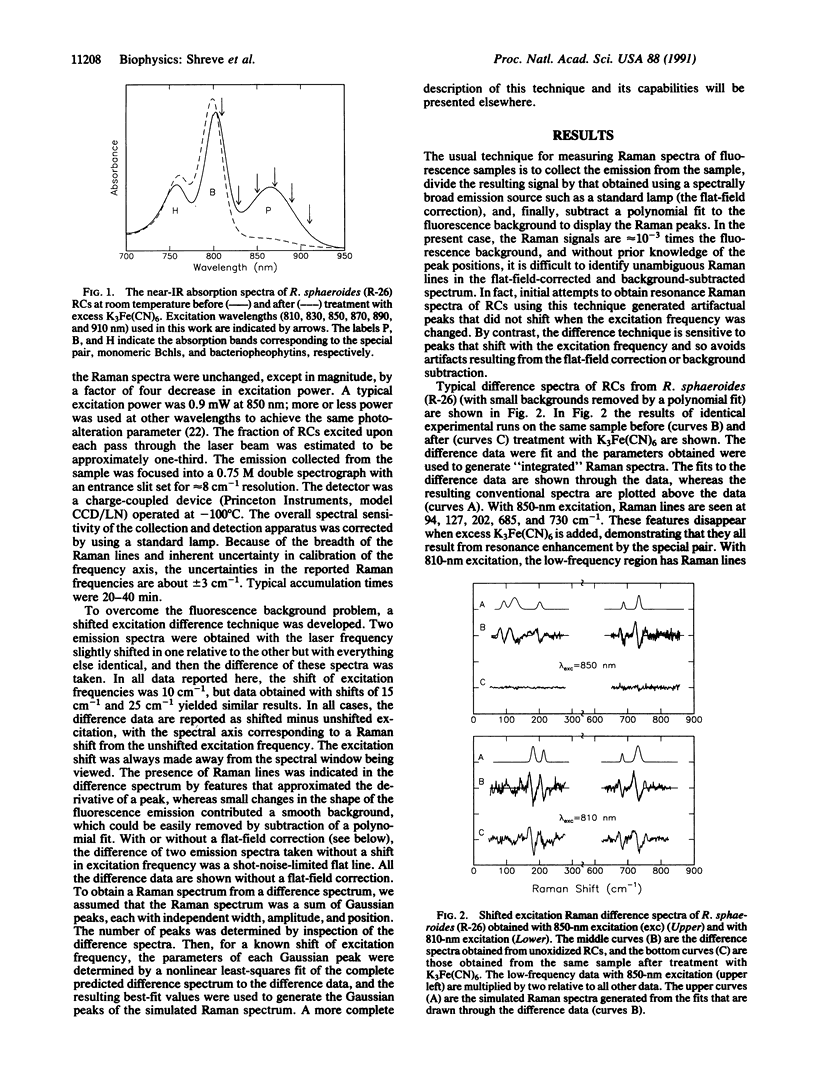
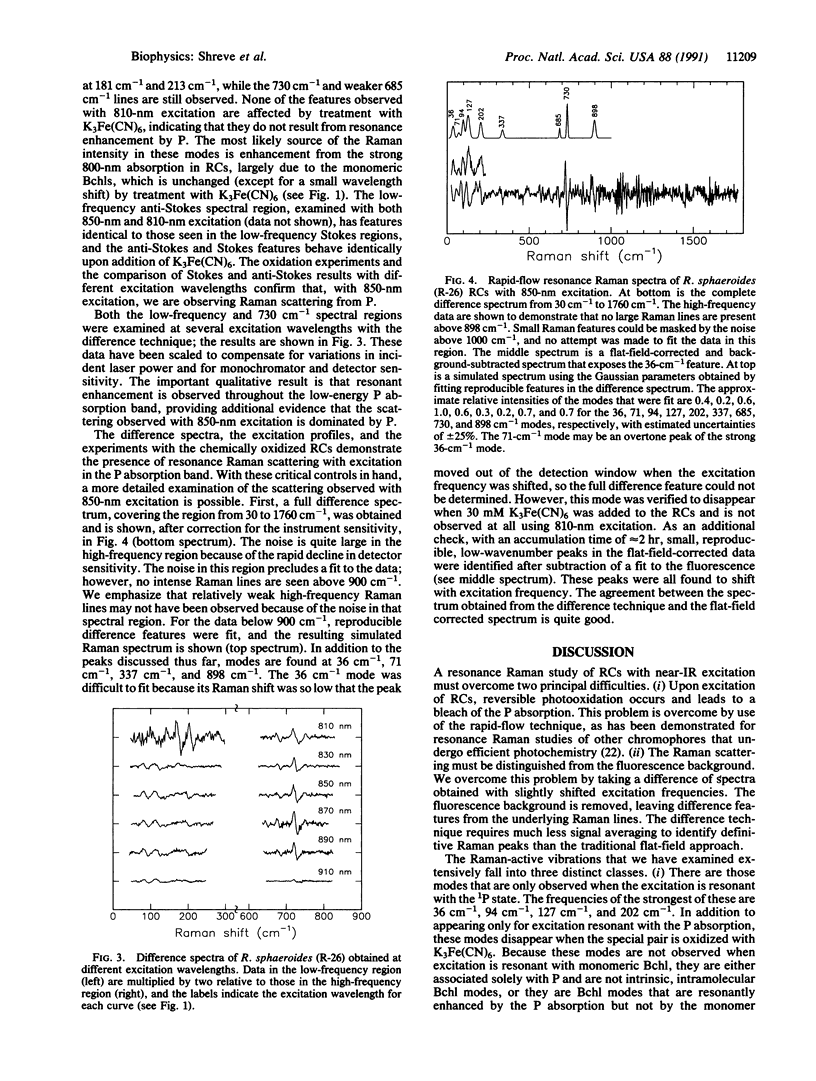
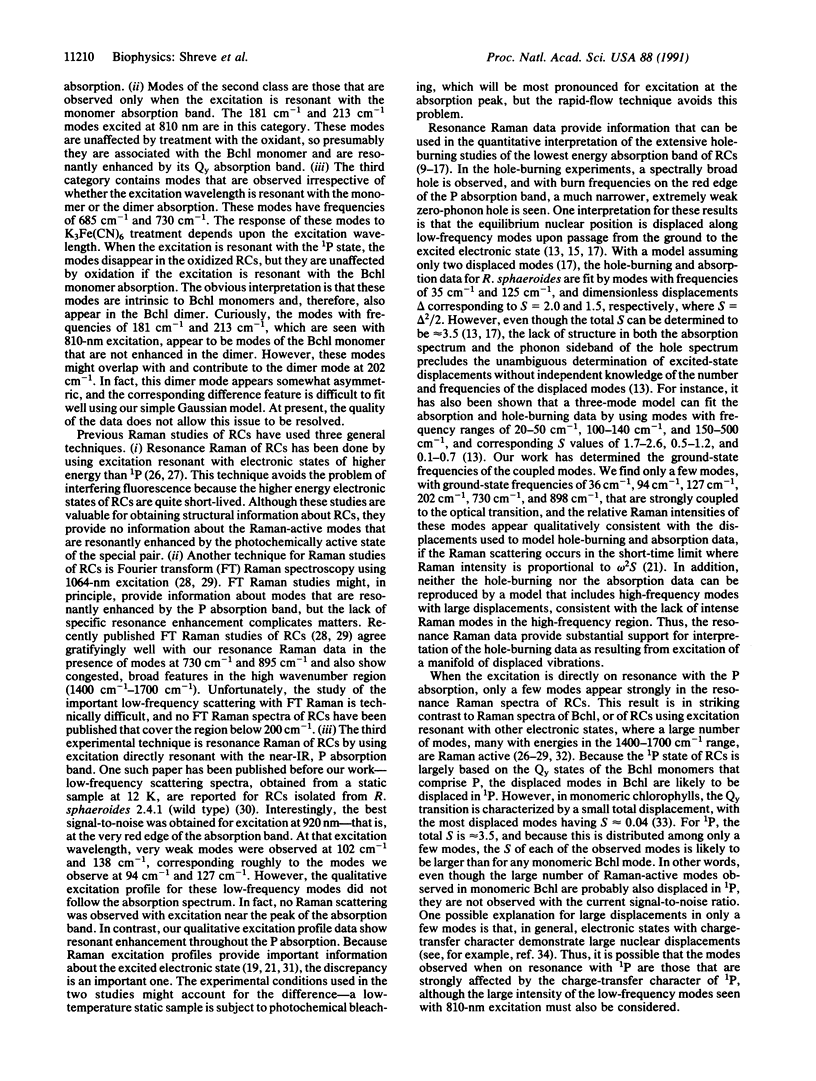
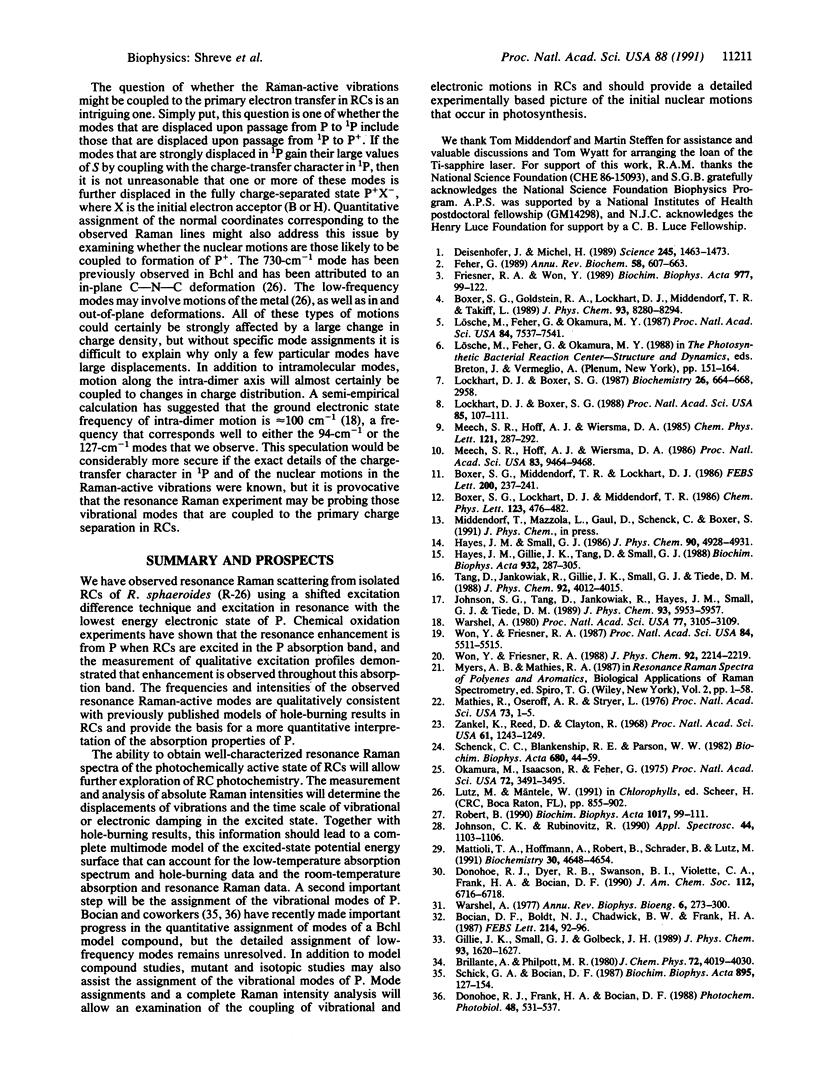
Selected References
These references are in PubMed. This may not be the complete list of references from this article.
- Bocian D. F., Boldt N. J., Chadwick B. W., Frank H. A. Near-infrared-excitation resonance Raman spectra of bacterial photosynthetic reaction centers. Implications for path-specific electron transfer. FEBS Lett. 1987 Apr 6;214(1):92–96. doi: 10.1016/0014-5793(87)80019-4. [DOI] [PubMed] [Google Scholar]
- Deisenhofer J., Michel H. The Photosynthetic Reaction Center from the Purple Bacterium Rhodopseudomonas viridis. Science. 1989 Sep 29;245(4925):1463–1473. doi: 10.1126/science.245.4925.1463. [DOI] [PubMed] [Google Scholar]
- Donohoe R. J., Frank H. A., Bocian D. F. Resonance Raman spectra and normal mode descriptions of a bacteriochlorophyll a model complex. Photochem Photobiol. 1988 Oct;48(4):531–537. doi: 10.1111/j.1751-1097.1988.tb02857.x. [DOI] [PubMed] [Google Scholar]
- Friesner R. A., Won Y. D. Spectroscopy and electron transfer dynamics of the bacterial photosynthetic reaction center. Biochim Biophys Acta. 1989 Nov 23;977(2):99–122. doi: 10.1016/s0005-2728(89)80062-3. [DOI] [PubMed] [Google Scholar]
- Lockhart D. J., Boxer S. G. Stark effect spectroscopy of Rhodobacter sphaeroides and Rhodopseudomonas viridis reaction centers. Proc Natl Acad Sci U S A. 1988 Jan;85(1):107–111. doi: 10.1073/pnas.85.1.107. [DOI] [PMC free article] [PubMed] [Google Scholar]
- Lösche M., Feher G., Okamura M. Y. The Stark effect in reaction centers from Rhodobacter sphaeroides R-26 and Rhodopseudomonas viridis. Proc Natl Acad Sci U S A. 1987 Nov;84(21):7537–7541. doi: 10.1073/pnas.84.21.7537. [DOI] [PMC free article] [PubMed] [Google Scholar]
- Mathies R., Oseroff A. R., Stryer L. Rapid-flow resonance Raman spectroscopy of photolabile molecules: rhodopsin and isorhodopsin. Proc Natl Acad Sci U S A. 1976 Jan;73(1):1–5. doi: 10.1073/pnas.73.1.1. [DOI] [PMC free article] [PubMed] [Google Scholar]
- Mattioli T. A., Hoffmann A., Robert B., Schrader B., Lutz M. Primary donor structure and interactions in bacterial reaction centers from near-infrared Fourier transform resonance Raman spectroscopy. Biochemistry. 1991 May 14;30(19):4648–4654. doi: 10.1021/bi00233a002. [DOI] [PubMed] [Google Scholar]
- Meech S. R., Hoff A. J., Wiersma D. A. Role of charge-transfer states in bacterial photosynthesis. Proc Natl Acad Sci U S A. 1986 Dec;83(24):9464–9468. doi: 10.1073/pnas.83.24.9464. [DOI] [PMC free article] [PubMed] [Google Scholar]
- Okamura M. Y., Isaacson R. A., Feher G. Primary acceptor in bacterial photosynthesis: obligatory role of ubiquinone in photoactive reaction centers of Rhodopseudomonas spheroides. Proc Natl Acad Sci U S A. 1975 Sep;72(9):3491–3495. doi: 10.1073/pnas.72.9.3491. [DOI] [PMC free article] [PubMed] [Google Scholar]
- Rees D. C., Komiya H., Yeates T. O., Allen J. P., Feher G. The bacterial photosynthetic reaction center as a model for membrane proteins. Annu Rev Biochem. 1989;58:607–633. doi: 10.1146/annurev.bi.58.070189.003135. [DOI] [PubMed] [Google Scholar]
- Schick G. A., Bocian D. F. Resonance Raman studies of hydroporphyrins and chlorophylls. Biochim Biophys Acta. 1987;895(2):127–154. doi: 10.1016/s0304-4173(87)80011-3. [DOI] [PubMed] [Google Scholar]
- Warshel A. Interpretation of resonance Raman spectra of biological molecules. Annu Rev Biophys Bioeng. 1977;6:273–300. doi: 10.1146/annurev.bb.06.060177.001421. [DOI] [PubMed] [Google Scholar]
- Warshel A. Role of the chlorophyll dimer in bacterial photosynthesis. Proc Natl Acad Sci U S A. 1980 Jun;77(6):3105–3109. doi: 10.1073/pnas.77.6.3105. [DOI] [PMC free article] [PubMed] [Google Scholar]
- Won Y., Friesner R. A. Simulation of photochemical hole-burning experiments on photosynthetic reaction centers. Proc Natl Acad Sci U S A. 1987 Aug;84(16):5511–5515. doi: 10.1073/pnas.84.16.5511. [DOI] [PMC free article] [PubMed] [Google Scholar]
- Zankel K. L., Reed D. W., Clayton R. K. Fluorescence and photochemical quenching in photosynthetic reaction centers. Proc Natl Acad Sci U S A. 1968 Dec;61(4):1243–1249. doi: 10.1073/pnas.61.4.1243. [DOI] [PMC free article] [PubMed] [Google Scholar]


